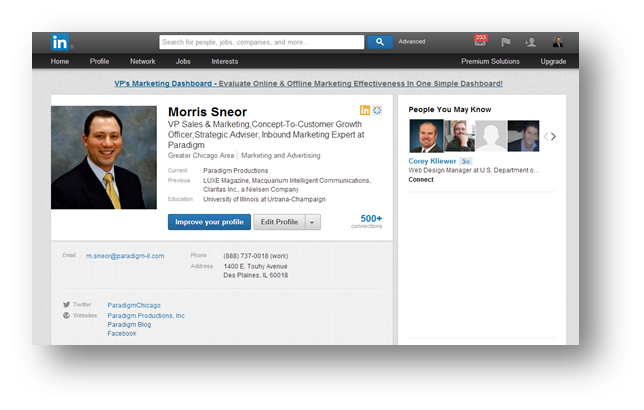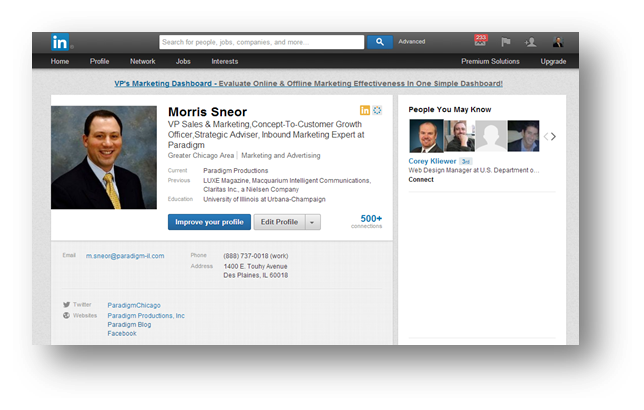Enhance Your Lead Generation Process By Strategically Constructing Your LinkedIn Profile
LinkedIn quickly becomes an essential cog in the lead generation process once B2B companies understand how to use it. Those who experience the most success in their brand-building efforts discovered a path to follow and take it regularly. If you have recognized LinkedIn’s potential but haven’t found your rhythm yet, consider this framework to get you started.
For this blog, we’ll focus on seven critical elements of your LinkedIn profile. We recognize the Personal LinkedIn profiles are critical to fostering credibility and trust, as well as initiating interest and relationships. Let’s look at some of high-level “Must Have’s” to construct an effective, engaging, and conversion-oriented personal LinkedIn profile:

Before starting, imagine the type of people who you would want reading your profile. How would you attract their attention, keep them interested and engaged? Begin with the end in mind, then work backward. Ask yourself, what impression do you want to make? What points do you want to be remembered about yourself? What action do you want to be taken after reading your profile? Remember that although this is your profile, it’s all about them – the potential customers, constituents, partners you want to attract.
1. LinkedIn Profile URL – Customize your LinkedIn URL. This is the web address of your individual LinkedIn profile. LinkedIn initially creates a URL with your name followed by a long string of numbers, and it’s simple to change that to something easier to link to as well find in search. Decide whether you want to use your name or your keywords in your URL.
- Name example: LinkedIn.com/in/morrissneor
- Keyword example: LinkedIn.com/in/professionalmarketing
2. Your Headshot – Be sure that this picture only has you in it, and it doesn’t like your photo was cropped out of a group shot. It is also recommended that this shot be professionally taken, kept current, and reflective of the brand persona you’re consciously representing with your lead generation efforts on LinkedIn.
3. Headline – Optimize your headline using keyword phrases to be searchable and engaging. Your headlines should be well thought out and created with care since it is visible in search engine and LinkedIn results, LinkedIn in emails, and other critical places. Just like most ads, 80% of the advertisements’ success depends on a strong headline to draw in attention and lead readers through the body copy.
4. Summary – The summary section begins the text area and your profile’s body copy. Since this section provides the greatest freedom and flexibility to deviate from LinkedIn’s patterned and predictable format, here’s your chance to differentiate and separate yourself from the pack. So consider each paragraph, sentence, and word very carefully, beginning with your opening paragraph. Seed Keywords and phrases generously but judiciously to help you be found on external search engines and LinkedIn’s own search box. Your summary should describe what skills and benefits you bring to your business, and subsequently, your prospects. Consider the first paragraph your eight-second pitch, thoughtfully crafted to be clear, concise, crisp, and compelling.
-
Where appropriate, offer actionable links to calls to action, like whitepaper downloads, sales team contacts, etc. to advance visitors to the next logical step in the decision-making process. The key is not to use too many links, and not to appear solicitous. These links should be used to make it convenient for readers to follow their natural course of action.
-
Keep these links current and edit them as your marketing strategy shifts with the needs of your target segment. You may also want to periodically check each link to ensure they aren’t broken, which happens from time to time.
-
To help visitors scan your profile, use bullet points, short sentences, and white space. Begin writing your summary section with a “straw man” of essential points you deem critical. Ask yourself, “if nothing more was remembered but three critical points, what would they be?” Start with these three points and build the rest of the summary around them.
5. Gallery – You can now include multimedia in your gallery, not just photos.
- Display samples of your work, your company, events, etc.
- Link to your uploaded photos, images, presentations, videos, audio, PDFs (reports or whitepapers).
- Use a 30-second introductory video that welcomes visitors and explains what they can expect to find in the gallery and benefit from.
- Insert a call to action link in gallery descriptions, when appropriate.
- Replace “click here” links with descriptive and compelling text links like “3 Secrets Your Marketing Firm Hasn’t Told You ”, which links to a related page on your website or even a separate landing page.
Although you don’t want to appear smug, remember that every element in your gallery contributes to “your story”, your “brand persona” and is meant to establish credibility, trust, and a positive impression. The Gallery section is analogous to a personal portfolio that’s vetted, curated, and reflective of you.
6. Contact Info – Each profile has a Contact Info section which is often overlooked or underutilized. You can add up to three hyperlinks here, and customize them so they call visitors to action.
7. Represent Your Brand – Be sure your verbiage, your links, and your profile as a whole represent your company and confirm that you are listed within its employee roster on your Company Page.
When you add a company to your work history and note that you are currently employed there, your profile will be visible to anyone who searches staff members from the Company page. With this in mind, be sure that your messaging and industry experience adds to the company’s strengths and do not detract from them. Your profile becomes an added benefit to that lead generation potential of your company’s LinkedIn page.
Once you strategically construct your LinkedIn profile, you can now begin building a network within your existing contacts to beef up the validity of your profile content and increase lead conversion potential. We’ll talk about those steps, including endorsements and recommendations, in upcoming posts. In the next blog, we’ll take a close look at the LinkedIn Company page. Check back for our next post!

